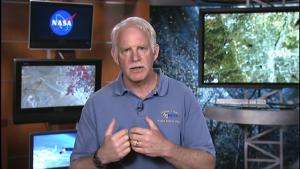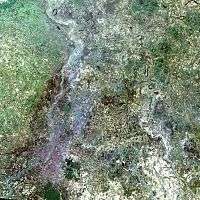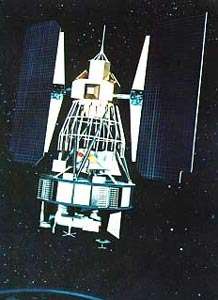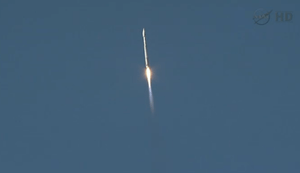Landsat program


The Landsat program is the longest-running enterprise for acquisition of satellite imagery of Earth. On July 23, 1972 the Earth Resources Technology Satellite was launched. This was eventually renamed to Landsat.[1] The most recent, Landsat 8, was launched on February 11, 2013. The instruments on the Landsat satellites have acquired millions of images. The images, archived in the United States and at Landsat receiving stations around the world, are a unique resource for global change research and applications in agriculture, cartography, geology, forestry, regional planning, surveillance and education, and can be viewed through the USGS 'EarthExplorer' website. Landsat 7 data has eight spectral bands with spatial resolutions ranging from 15 to 60 meters; the temporal resolution is 16 days.[2] Landsat images are usually divided into scenes for easy downloading. Each Landsat scene is about 115 miles long and 115 miles wide (or 100 nautical miles long and 100 nautical miles wide, or 185 kilometers long and 185 kilometers wide).
History
Hughes Santa Barbara Research Center initiated, designed, and fabricated the first three Multispectral Scanners (MSS) in 1969, the same year man landed on the moon. The first prototype MSS was completed within nine months, in the fall of 1970. It was tested by scanning Half Dome at Yosemite National Park.
The program was initially called the Earth Resources Technology Satellites Program, which was used from 1966 to 1975. In 1975, the name was changed to Landsat. In 1979, President of the United States Jimmy Carter's Presidential Directive 54 transferred Landsat operations from NASA to NOAA, recommended development of a long term operational system with four additional satellites beyond Landsat 3, and recommended transition to private sector operation of Landsat. This occurred in 1985 when the Earth Observation Satellite Company (EOSAT), a partnership of Hughes Aircraft and RCA, was selected by NOAA to operate the Landsat system with a ten-year contract. EOSAT operated Landsat 4 and Landsat 5, had exclusive rights to market Landsat data, and was to build Landsats 6 and 7.

In 1989, this transition had not been fully completed when NOAA's funding for the Landsat program was due to run out (NOAA had not requested any funding, and Congress had appropriated only six months of funding for the fiscal year)[3] and NOAA directed that Landsats 4 and 5 be shut down.[4] The head of the newly formed National Space Council, Vice President Dan Quayle, noted the situation and arranged emergency funding that allowed the program to continue with the data archives intact. [3][4][5][6]
Again in 1990 and 1991, Congress provided only half of the year's funding to NOAA, requesting that agencies that used Landsat data provide the funding for the other six months of the upcoming year.[3] In 1992, various efforts were made to procure funding for follow on Landsats and continued operations, but by the end of the year EOSAT ceased processing Landsat data. Landsat 6 was finally launched on October 5, 1993, but was lost in a launch failure. Processing of Landsat 4 and 5 data was resumed by EOSAT in 1994. NASA finally launched Landsat 7 on April 15, 1999.
The value of the Landsat program was recognized by Congress in October 1992 when it passed the Land Remote Sensing Policy Act (Public Law 102-555) authorizing the procurement of Landsat 7 and assuring the continued availability of Landsat digital data and images, at the lowest possible cost, to traditional and new users of the data.
Satellite chronology
| Instrument | Picture | Launched | Terminated | Duration | Notes |
|---|---|---|---|---|---|
| Landsat 1 |  | July 23, 1972 | January 6, 1978 | 2 years, 11 months and 15 days | Originally named Earth Resources Technology Satellite 1. |
| Landsat 2 |  | January 22, 1975 | February 25, 1982 | 2 years, 10 months and 17 days | Nearly identical copy of Landsat 1 |
| Landsat 3 |  | March 5, 1978 | March 31, 1983 | 5 years and 26 days | Nearly identical copy of Landsat 1 and Landsat 2 |
| Landsat 4 |  | July 16, 1982 | December 14, 1993 | 11 years, 4 months and 28 days | |
| Landsat 5 |  | March 1, 1984 | June 5, 2013[7] | 29 years, 3 months and 4 days | Nearly identical copy of Landsat 4. Longest Earth-observing satellite mission in history. |
| Landsat 6 | | October 5, 1993 | October 5, 1993 | 0 days | Failed to reach orbit. |
| Landsat 7 |  | April 15, 1999 | Still active | 17 years, 7 months and 27 days | Operating with scan line corrector disabled since May 2003.[8] |
| Landsat 8 |  | February 11, 2013 | Still active | 3 years, 10 months and 1 day | Originally named Landsat Data Continuity Mission from launch until May 30, 2013, when NASA operations were turned over to USGS.[9] |
- Timeline

Technical details

The Multispectral Scanner had a 230 mm (9 in) fused silica dinner-plate mirror epoxy bonded to three invar tangent bars mounted to base of a Ni/Au brazed Invar frame in a Serrurier truss that was arranged with four "Hobbs-Links" (conceived by Dr. Gregg Hobbs), crossing at mid-truss. This construct ensured the secondary mirror would simply oscillate about the primary optic axis to maintain focus despite vibration inherent from the 360 mm (14 in) beryllium scan mirror. This engineering solution allowed the United States to develop LANDSAT at least five years ahead of the French SPOT, which first used CCD arrays to stare without need for a scanner. However, LANDSAT data prices climbed from $250 per computer compatible data tape and $10 for black-and-white print to $4,400 for data tape and $2,700 for black-and-white print by 1984, making SPOT data a much more affordable option for satellite imaging data. This was a direct result of the commercialization efforts begun under the Carter administration (Presidential Directive 54 in 1979, noted above), though finally completed under the Reagan administration.[10]
The MSS FPA, or Focal Plane Array consisted of 24 square optical fibers extruded down to 0.005 mm (0.0002 in) square fiber tips in a 4x6 array to be scanned across the Nimbus spacecraft path in a ±6 degree scan as the satellite was in a 1.5 hour polar orbit, hence it was launched from Vandenberg Air Force Base. The fiber optic bundle was embedded in a fiber optic plate to be terminated at a relay optic device that transmitted fiber end signal on into six photodiodes and 18 photomultiplier tubes that were arrayed across a 7.6 mm (0.30 in) thick aluminum tool plate, with sensor weight balanced vs the 230 mm telescope on opposite side. This main plate was assembled on a frame, then attached to the silver-loaded magnesium housing with helicoil fasteners.
Key to the success of the multi spectral scanner was the scan monitor mounted on the underbelly of the magnesium housing. It consisted of a diode light source and a sensor mounted at the ends of four flat mirrors that were tilted so that it took 14 bounces for a beam to reflect the length of the three mirrors from source to sender. The beam struck the beryllium scan mirror seven times as it reflected seven times off the flat mirrors. The beam only sensed three positions, being both ends of scan and the mid scan, but by interpolating between these positions that was all that was required to determine where the multi spectral scanner was pointed. Using the scan monitor information the scanning data could be calibrated to display correctly on a map.
Future
Landsat 8, launched 11 February 2013, is the most recent satellite in the Landsat series. It was launched on an Atlas V 401 from Vandenberg Air Force Base by the Launch Services Program. It will continue to obtain valuable data and imagery to be used in agriculture, education, business, science, and government. The new satellite was assembled in Arizona by Orbital Sciences Corporation.
Preliminary planning has begun for Landsat 9, though its future remains uncertain.[11] Over the course of FY2014 financial planning "appropriators chided NASA for unrealistic expectations that a Landsat 9 would cost $1 billion, and capped spending at $650 million" according to a report by the Congressional Research Service. Senate appropriators have advised NASA to plan for a launch no later than 2020.[12] In April 2015, NASA and the U.S. Geological Survey (USGS) announced that work on Landsat 9 had commenced, with funding allocated for the satellite in the president's FY2016 budget, for a planned launch in 2023.[13] Funding for the development of a low-cost thermal infrared (TIR) free-flying satellite for launch in 2019 was also proposed, to ensure data continuity by flying in formation with Landsat 8.[13]


.ogv.jpg)

See also
- Earth observation satellite
- Geographic information system
- Orthophoto, corrected for uniform scale like a map
- Remote sensing
References
- ↑ Short, N.M. "The LANDSAT Tutorial Workbook: Basics of Satellite Remote Sensing". NASA Reference Publication 1078. NASA. Retrieved 20 September 2011.
- ↑ The Landsat Program - Technical Details
- 1 2 3 Greenberg, Joel S.; Hertzfeld, Henry (1992). Space Economics. AIAA (American Institute of Aeronautics & Ast). p. 372. ISBN 1-56347-042-X.
- 1 2 United Press International (1989-03-03). "Govt. pulls the plug on two satellites, threatening jobs". Ellensburg Daily Record. Retrieved 2010-05-19.
- ↑ Associated Press (1989-03-07). "Quayle backs satellite program". The Lewiston Journal. Retrieved 2010-05-19.
- ↑ John Noble Wilford (1989-03-17). "U.S. Halts Plan to Turn Off the Landsat Satellites". The New York Times. Retrieved 2010-05-19.
- ↑
- ↑ The Landsat Program
- ↑ "Landsat 8 Data Now Available!". May 30, 2013. USGS. Retrieved May 30, 2013.
- ↑ http://www.the-scientist.com/?articles.view/articleNo/17221/title/Failure-Of-Landsat-6-Leaves-Many-Researchers-In-Limbo/
- ↑ http://ens-newswire.com/2013/08/08/uncertain-funding-jeopardizes-u-s-land-imaging-satellites/
- ↑ https://fas.org/sgp/crs/misc/R40594.pdf
- 1 2 http://www.nasa.gov/press/2015/april/nasa-usgs-begin-work-on-landsat-9-to-continue-land-imaging-legacy/
External links
| Wikimedia Commons has media related to |
- Landsat USGS homepage
- Landsat NASA homepage
- Works by Landsat at Project Gutenberg
- Landsat imagery from GLOVIS and Global Land Cover Facility
- Landsat mosaic imagery from the WELD project.